#web based product configurator
Explore tagged Tumblr posts
Text

1 note
·
View note
Text
Voltaire's Prayer
“I have never made but one prayer to God, a very short one: Oh Lord, make my enemies ridiculous. And God granted it." -Volaire’s letter to Étienne Noël Damilaville, 16 May 1767
I’m inordinately fond of sex, in the political sense. It’s saved us so often from the worst parts of ourselves.
As far as anti-authoritarian elements of the human experience go, sex is right up there with curiosity and the search for truth- maybe even more so. When a new tyrant comes to town, shutting down the universities and the libraries is only the second thing they try. The first thing is to regulate human sexuality to within an inch of its life. Rules for marriage, rules for courtship, rules for which genitals may touch and where they may touch and when they may touch. Rules for who and rules for whom. Rules for which kinds of sex must doom characters in literature, rules for which things may be described as sexy, rules for which things may be described in a sexy way.
Of course they do! If you’re trying to bind a large polity together under a common ideological narrative, to render people predictable enough to quash dissent and legible enough to exert power through them, the last thing you need is a bunch of folks running around being horny about stuff without permission. Nature gifted us with a great capacity for reason and community; we have the innate opportunity to learn about ourselves and our neighbors, and to form complex societies based on that understanding. It was Aristotle who first called us the political animal, and the fruits of that extraordinary capacity will always be within our reach, if only we can come together within a shared understanding. The invention of the city is the great triumph of our species, and with it we conquer the universe.
But also this extraordinary, reasoning mind has been sculpted from the raw clay of a biology that’s anchored in sexual reproduction, and this ends up being very, very funny.
The problem isn’t so much that the sex instinct exists, per se. It’s how it’s implemented. Like most biological forms, the full complement of 86 billion(!) neurons in your brain aren’t encoded in a particular configuration; the brain is much too complex to be described so precisely in the only ~725 megabytes or so of human DNA. The particular shape of your brain is in there somewhere- the lobes and subregions responsible for vision, memory, cognition, all that- but only up to a point. The genius and fundamental limitation of genetics is that, below a certain level, the genes instead describe a process for the production and reproduction of specialized cells, and simply constructs them in such a way that they can be relied upon to order themselves as they go.
This is all well and good when we’re talking about kidneys and livers, but the fact that you can encode any kind of specific behavioral instinct in a brain this way is nothing short of a minor miracle. Think about it! Spiders don’t have a ‘spider web’ gene, the gene is for ‘proteins that come together in self-assembling electrochemically sensitive gelatin tissue which, when complete, encodes patterns that operate organ systems such as legs and spinnerets in such a way as to reliably create silk webs.’ This is absurdly impressive, and also completely insane.
What I’m getting at is, powerful behavioral instincts in a complex animal aren’t precise instruction manuals by which we pursue evolutionarily advantageous behaviors. Sex and eros are prior to logic or language, let alone strategy. Sex is a double-thick electrical wire discharging lightning bolts right through the middle of our cognitive centers, installed in the brain by a surgeon wearing mittens. It’s an untethered firehose whipping chaotically through the cathedral, unpredictably spraying golden reliquaries with substances unmentionable. It’s the first and greatest anarchist.
I really can’t overstate my gratitude for this.
Obviously this results in any number of deeply goofy outcomes by way of kinks and odd sexual practices- it gets tangled with pain centers, with random bits of anatomy and proprioception, with our taboos and aversions, with our greatest terrors or our greatest yearnings or just arbitrary stimuli from adolescence, and of course it gets enmeshed so often with our notions of power and submission. It imbues these things with a fascination and potency out of all proportion with their mundane meanings. And ultimately, you end up with human pleasures and human values that diverge so far from banal evolutionary imperatives as to be all but unrecognizable.
Even when this process somehow manages to propagate through the brain in such a way as to drive behaviors that are legibly aligned towards some adaptive constraint- e.g. heterosexual mating practices resulting in biological reproduction and careful childrearing- it’s still madness. Love and sex penetrate deeply across tribal and national and racial boundaries, across economic interests, across battle-lines and enmities. We become traitors, apostates, emigrants, and artists. Declare a law, and in short order some hot-headed young people come along to break it in the name of sexual passions you could not possibly have seen coming. Divide your neighborhood into us and them, and by the time the ink is dry on your proclamation there will be a forbidden relationship across the fence. There is no social order, no ethical system, no theory of human nature that can entirely withstand contact with the full spectrum of human sexuality, because sex and eros are always going to be exactly as bonkers as the complexity of the human mind and culture will allow, plus a little extra just to be sure.
This isn’t always a delight, of course. Many prohibitions exist for a very good reason, and the chaos of human sexuality makes no exemptions for true evil. Some of us end up really, truly victims of this process. But for all the dangers, the chaos at the root of all this isn’t oriented towards evil. Chaos just means chaos, essentially arbitrary and hence absurd in character.
And in the grand analysis, we are so lucky to have this thing moving through our communities, this ridiculous madness that guarantees that there will be cracks in every wall and slips exploding cigars in the pockets of the powerful few. Not in everybody as individuals, of course, and not everybody the same amount; asexuality is certainly one of the outcomes that all this mad gallivanting through our brains can produce. Sexuality would never be so predictable as to guarantee its own existence, after all. That’s part of what makes the joke so funny.
But all of us, regardless of sexuality, get to live in a world where the grand anarchy of sex is constantly driving home this lesson that no category is inviolate and no law is perfect. That we should not and cannot take ourselves too seriously, or forget that we’re animals. That we don’t exist only for the sake of others, or within their understanding. That cities are made of cooperation, grace, and forbearance- not conformity or mere compliance.
People sometimes worry about immortality. In the political sense, I mean. They worry about eternal dictatorships and unconquerable gerontocracies. This fear isn’t entirely unjustified; death has often played a role in progress and liberation. But as long as enough of us are still getting horny without permission, still falling in love in stupid ways, I think we’ll be okay. Romeo and Juliet don’t have to die at the end to make a difference in the world, as long as they’re brave enough to get weird with it.
723 notes
·
View notes
Note
what do you like about emacs?
a lot of things, really! I will refer you to the documentation for Doom Emacs for a short answer to this question that I agree with, or you can keep reading for my much, much longer answer. :)
as a software that predates modern text editors and IDEs, emacs breaks the mold when it comes to the established design patterns of these tools. in some cases this can be a problem: emacs is notoriously slow (though somehow still faster than modern IDEs on my machine lol), and its default keybindings are horrendous. but it is also emacs's greatest strength: the sheer versatility and extensability of its design is unmatched by any other tool in existence.
the first thing you need to know about emacs is that.. it's not really a text editor. I mean, that may be the mission statement on the website, and that's certainly what it was when it started out, but as it's developed it's become more than that. emacs is a software platform for text-based applications.
the entirety of emacs is designed to function as one big interpreter for the language Emacs Lisp (elisp for short). when you press a key on your keyboard in emacs, say the Enter key, that keypress is sent to emacs's standard library code written in elisp. the code looks up that key in a keymap, which associates it to a particular elisp subroutine to run (specifically "newline-and-indent"), which accesses the file you're currently editing and makes the corresponding change.
every aspect of that process is configurable directly through the elisp language. you can rebind the key to a different action, of course, but you can also edit the "newline-and-indent" subroutine to do something else, or edit any other elisp function. you can switch between multiple keymaps (a keymap is just a lisp object) on some condition, such as opening a particular file. you can even tell emacs to display text that isn't linked to any file and alter the keymap when the user is interacting with that text to contain your own custom bindings. in effect, you can create any text-based interface you want.
here is a non-exhaustive list of all of the things that I have used emacs as:
IDE
Prose editor
File manager
Calculator
Productivity tool
Email client
Calendar
Web browser
Tetris
all of these tools use, to varying degrees, the techniques I mentioned above to directly modify how emacs functions through elisp. with a little knowledge of the language, you can modify these tools to your liking just as easily as you can modify emacs itself. emacs becomes a unified interface for a hundred different applications, all of which are fully configurable and self-documenting. (yeah I didn't even mention that emacs is self-documenting within its code until now).
.. so it's not even really that I "prefer" emacs, because that framing implies that there are alternatives that are equal in scope or utility. I use emacs because it is the only thing that does what emacs does.
Emacs outshines all other editing software in approximately the same way that the noonday sun does the stars. It is not just bigger and brighter; it simply makes everything else vanish.
- Neil Stepheson, In the Beginning was the Command Line (1998)
#come on. you know i had to pull out The Quote#emacs#gnu emacs#programming#computers#tokinanpa#ask answered
14 notes
·
View notes
Text
Spring Boot Interview Questions: Prepare for Success
Spring Boot has become one of the most popular frameworks in the Java ecosystem, streamlining robust and scalable web application development. Whether you’re a seasoned developer or just getting started, acing a Spring Boot interview can be a significant milestone in your career. To help you prepare effectively, here are the latest Spring Boot interview questions that will test your knowledge and give you a deeper understanding of how the framework works. These questions will be beneficial if you're pursuing a Spring Boot Certification Training Course at eMexo Technologies, in Electronic City Bangalore.
1. What is Spring Boot, and how is it different from Spring Framework?
This is a fundamental question that often appears in Spring Boot interviews. Spring Boot is an extension of the Spring Framework to simplify the development process. It eliminates the need for extensive XML configuration and provides default configurations to facilitate rapid application development. Spring Framework requires developers to configure components manually, while Spring Boot auto-configures them.
By understanding this, you can highlight how Spring Boot training in Electronic City Bangalore at eMexo Technologies helps developers focus more on writing business logic rather than dealing with complex configurations.
2. What are the main features of Spring Boot?
Spring Boot stands out due to several features:
Auto-Configuration: Automatically configures your application based on the libraries on the classpath.
Embedded Servers: It allows the deployment of web applications on embedded servers like Tomcat, Jetty, and Undertow.
Spring Boot Starters: Pre-configured templates that simplify dependency management.
Spring Boot CLI: A command-line interface that allows you to develop Spring applications quickly.
Actuator: Monitors and manages application performance.
These features make Spring Boot an attractive option for developers, which is why the best Spring Boot training institute in Electronic City Bangalore emphasizes hands-on experience with these functionalities.
3. What is the role of @SpringBootApplication in Spring Boot?
The @SpringBootApplication annotation is a core part of Spring Boot, often referred to as the ‘meta-annotation.’ It is a combination of three annotations:
@Configuration: Marks the class as a configuration class for Spring Beans.
@EnableAutoConfiguration: Enables Spring Boot’s auto-configuration feature.
@ComponentScan: Scans the components within the specified package.
This annotation is crucial to understanding Spring Boot’s internal architecture and its ability to simplify configuration.
4. What is Spring Boot Starter, and how is it useful?
A Spring Boot Starter is a set of pre-configured dependencies that simplify the inclusion of libraries in your project. For instance, spring-boot-starter-web includes everything you need for web development, like Spring MVC, embedded Tomcat, and validation support.
Starters save a lot of time, as they eliminate the need to find and include individual dependencies manually. When studying at eMexo Technologies, you’ll get an in-depth look at the variety of Spring Boot Starters available and their importance in building scalable applications.
5. What is a Spring Boot Actuator, and how is it used?
Spring Boot Actuator provides production-ready features to help monitor and manage your Spring Boot application. It offers a wide array of tools like health checks, metrics, and auditing endpoints. The actuator allows you to easily monitor application performance, which is a crucial aspect of microservices-based applications.
6. What are Microservices, and how does Spring Boot help in building them?
Microservices are small, independent services that work together in a larger application. Each service is responsible for a specific business functionality and can be developed, deployed, and maintained independently. Spring Boot simplifies the development of microservices by providing tools like Spring Cloud and Spring Boot Actuator.
7. How does Spring Boot handle dependency injection?
Dependency Injection (DI) is a key feature of the Spring Framework, and Spring Boot uses it to manage object creation and relationships between objects automatically. In Spring Boot, DI is usually handled through annotations like @Autowired, @Component, and @Service.
8. How can you configure a Spring Boot application?
Spring Boot applications can be configured in multiple ways:
application.properties or application.yml files.
Using the @Configuration classes.
Via command-line arguments.
Environment variables.
9. What are profiles in Spring Boot, and how are they used?
Profiles in Spring Boot allow developers to create different configurations for different environments. For example, you can have one profile for development, one for testing, and one for production. You can specify which profile to use by setting it in the application.properties file or as a command-line argument.
10. What are the limitations of Spring Boot?
Despite its many benefits, Spring Boot has some limitations:
Lack of control over auto-configuration can sometimes lead to unexpected behaviors.
Increased memory usage due to embedded servers.
Limited flexibility in large-scale applications that require extensive custom configuration.
Addressing these limitations demonstrates that you have a well-rounded understanding of the framework and can make informed decisions about when and where to use it.
11. How does Spring Boot handle security?
Spring Boot simplifies security through Spring Security, which can be easily integrated into your application. By adding the spring-boot-starter-security dependency, you can configure authentication and authorization in a few lines of code. You can also customize login, registration, and session management features.
12. What is the role of the Spring Initializr in Spring Boot?
The Spring Initializr is an online tool used to generate Spring Boot projects. It allows developers to choose the dependencies and configuration options before downloading the skeleton code. This tool speeds up the initial setup phase, saving time and effort.
In conclusion, being well-prepared for Spring Boot interviews is crucial, especially in a competitive job market. Whether you're taking a Spring Boot course in Electronic City Bangalore or aiming for Spring Boot Certification Training, knowing these key concepts will give you the edge you need. At eMexo Technologies, you’ll receive hands-on training, not just theory, preparing you to answer interview questions and excel in your career confidently.
Join Now: https://www.emexotechnologies.com/
#springboot#tech education#certification course#career growth#career development#tech skills#learning#learn to code#software training#emexo technologies#bangalore#technology
2 notes
·
View notes
Text
How to Integrate Testing Automation Tools into Your CI/CD Pipeline
Integrating testing automation tools into your Continuous Integration/Continuous Deployment (CI/CD) pipeline is crucial for enhancing software quality and accelerating delivery cycles. The first step is to select the right automation tool that aligns with your technology stack and project requirements. Popular choices include Selenium for web applications, Appium for mobile apps, and JUnit for Java-based projects.
Once the tool is chosen, configure your CI/CD pipeline to include automated testing at various stages. Begin with unit tests during the build phase to catch issues early. Tools like Jenkins, CircleCI, or GitLab CI can be configured to trigger these tests automatically with each code commit. Ensure that the testing environment mirrors the production setup to achieve accurate results.
Next, integrate automated functional and regression tests in the pre-deployment phase. These tests should validate end-to-end functionalities and ensure that new changes do not break existing features. Using frameworks like TestNG or Cucumber can help manage these tests effectively.
Additionally, incorporate performance and load testing tools like JMeter or Gatling to assess the application's behavior under stress. These tests can be scheduled to run during off-peak hours to avoid interference with regular development activities.
Finally, maintain a robust reporting mechanism to track test results and generate insights. Tools like Allure or TestRail can provide detailed reports and dashboards, facilitating quick identification and resolution of issues.
By strategically integrating testing automation tools into your CI/CD pipeline, you ensure a reliable, efficient, and scalable approach to software delivery, ultimately leading to higher quality products and faster release cycles.
#codeless test automation#codeless testing platform#test automation software#automated qa testing#no code test automation tools
3 notes
·
View notes
Text
Spring Security Using Facebook Authorization: A Comprehensive Guide
In today's digital landscape, integrating third-party login mechanisms into applications has become a standard practice. It enhances user experience by allowing users to log in with their existing social media accounts. In this blog post, we will walk through the process of integrating Facebook authorization into a Spring Boot application using Spring Security.
Table of Contents
Introduction
Prerequisites
Setting Up Facebook Developer Account
Creating a Spring Boot Application
Configuring Spring Security for OAuth2 Login
Handling Facebook User Data
Testing the Integration
Conclusion
1. Introduction
OAuth2 is an open standard for access delegation, commonly used for token-based authentication. Facebook, among other social media platforms, supports OAuth2, making it possible to integrate Facebook login into your Spring Boot application.
2. Prerequisites
Before we start, ensure you have the following:
JDK 11 or later
Maven
An IDE (e.g., IntelliJ IDEA or Eclipse)
A Facebook Developer account
3. Setting Up Facebook Developer Account
To use Facebook login, you need to create an app on the Facebook Developer portal:
Go to the Facebook Developer website and log in.
Click on "My Apps" and then "Create App."
Choose an app type (e.g., "For Everything Else") and provide the required details.
Once the app is created, go to "Settings" > "Basic" and note down the App ID and App Secret.
Add a product, select "Facebook Login," and configure the Valid OAuth Redirect URIs to http://localhost:8080/login/oauth2/code/facebook.
4. Creating a Spring Boot Application
Create a new Spring Boot project with the necessary dependencies. You can use Spring Initializr or add the dependencies manually to your pom.xml.
Dependencies
<dependencies> <dependency> <groupId>org.springframework.boot</groupId> <artifactId>spring-boot-starter-security</artifactId> </dependency> <dependency> <groupId>org.springframework.boot</groupId> <artifactId>spring-boot-starter-web</artifactId> </dependency> <dependency> <groupId>org.springframework.boot</groupId> <artifactId>spring-boot-starter-oauth2-client</artifactId> </dependency> <dependency> <groupId>org.springframework.boot</groupId> <artifactId>spring-boot-starter-thymeleaf</artifactId> </dependency> </dependencies>
5. Configuring Spring Security for OAuth2 Login
Next, configure Spring Security to use Facebook for OAuth2 login.
application.properties
Add your Facebook app credentials to src/main/resources/application.properties.spring.security.oauth2.client.registration.facebook.client-id=YOUR_FACEBOOK_APP_ID spring.security.oauth2.client.registration.facebook.client-secret=YOUR_FACEBOOK_APP_SECRET spring.security.oauth2.client.registration.facebook.redirect-uri-template={baseUrl}/login/oauth2/code/{registrationId} spring.security.oauth2.client.registration.facebook.scope=email,public_profile spring.security.oauth2.client.registration.facebook.client-name=Facebook spring.security.oauth2.client.registration.facebook.authorization-grant-type=authorization_code spring.security.oauth2.client.provider.facebook.authorization-uri=https://www.facebook.com/v11.0/dialog/oauth spring.security.oauth2.client.provider.facebook.token-uri=https://graph.facebook.com/v11.0/oauth/access_token spring.security.oauth2.client.provider.facebook.user-info-uri=https://graph.facebook.com/me?fields=id,name,email spring.security.oauth2.client.provider.facebook.user-name-attribute=id
Security Configuration
Create a security configuration class to handle the OAuth2 login.import org.springframework.context.annotation.Bean; import org.springframework.context.annotation.Configuration; import org.springframework.security.config.annotation.web.builders.HttpSecurity; import org.springframework.security.config.annotation.web.configuration.EnableWebSecurity; import org.springframework.security.config.annotation.web.configuration.WebSecurityConfigurerAdapter; import org.springframework.security.oauth2.client.oidc.userinfo.OidcUserService; import org.springframework.security.oauth2.client.userinfo.DefaultOAuth2UserService; import org.springframework.security.oauth2.client.userinfo.OAuth2UserService; import org.springframework.security.oauth2.core.oidc.user.OidcUser; import org.springframework.security.oauth2.core.user.OAuth2User; import org.springframework.security.web.authentication.SimpleUrlAuthenticationFailureHandler; @Configuration @EnableWebSecurity public class SecurityConfig extends WebSecurityConfigurerAdapter { @Override protected void configure(HttpSecurity http) throws Exception { http .authorizeRequests(authorizeRequests -> authorizeRequests .antMatchers("/", "/error", "/webjars/**").permitAll() .anyRequest().authenticated() ) .oauth2Login(oauth2Login -> oauth2Login .loginPage("/login") .userInfoEndpoint(userInfoEndpoint -> userInfoEndpoint .oidcUserService(this.oidcUserService()) .userService(this.oAuth2UserService()) ) .failureHandler(new SimpleUrlAuthenticationFailureHandler()) ); } private OAuth2UserService<OidcUserRequest, OidcUser> oidcUserService() { final OidcUserService delegate = new OidcUserService(); return (userRequest) -> { OidcUser oidcUser = delegate.loadUser(userRequest); // Custom logic here return oidcUser; }; } private OAuth2UserService<OAuth2UserRequest, OAuth2User> oAuth2UserService() { final DefaultOAuth2UserService delegate = new DefaultOAuth2UserService(); return (userRequest) -> { OAuth2User oAuth2User = delegate.loadUser(userRequest); // Custom logic here return oAuth2User; }; } }
6. Handling Facebook User Data
After a successful login, you might want to handle and display user data.
Custom User Service
Create a custom service to process user details.import org.springframework.security.oauth2.core.user.OAuth2User; import org.springframework.security.oauth2.core.user.OAuth2UserAuthority; import org.springframework.security.oauth2.client.userinfo.OAuth2UserService; import org.springframework.security.oauth2.client.oidc.userinfo.OidcUserService; import org.springframework.security.oauth2.core.oidc.user.OidcUser; import org.springframework.security.oauth2.client.userinfo.DefaultOAuth2UserService; import org.springframework.security.oauth2.client.oidc.userinfo.OidcUserRequest; import org.springframework.security.oauth2.client.userinfo.OAuth2UserRequest; import org.springframework.stereotype.Service; import java.util.Map; import java.util.Set; import java.util.HashMap; @Service public class CustomOAuth2UserService implements OAuth2UserService<OAuth2UserRequest, OAuth2User> { private final DefaultOAuth2UserService delegate = new DefaultOAuth2UserService(); @Override public OAuth2User loadUser(OAuth2UserRequest userRequest) { OAuth2User oAuth2User = delegate.loadUser(userRequest); Map<String, Object> attributes = new HashMap<>(oAuth2User.getAttributes()); // Additional processing of attributes if needed return oAuth2User; } }
Controller
Create a controller to handle login and display user info.import org.springframework.security.core.annotation.AuthenticationPrincipal; import org.springframework.security.oauth2.core.user.OAuth2User; import org.springframework.stereotype.Controller; import org.springframework.ui.Model; import org.springframework.web.bind.annotation.GetMapping; @Controller public class LoginController { @GetMapping("/login") public String getLoginPage() { return "login"; } @GetMapping("/") public String getIndexPage(Model model, @AuthenticationPrincipal OAuth2User principal) { if (principal != null) { model.addAttribute("name", principal.getAttribute("name")); } return "index"; } }
Thymeleaf Templates
Create Thymeleaf templates for login and index pages.
src/main/resources/templates/login.html
<!DOCTYPE html> <html xmlns:th="http://www.thymeleaf.org"> <head> <title>Login</title> </head> <body> <h1>Login</h1> <a href="/oauth2/authorization/facebook">Login with Facebook</a> </body> </html>
src/main/resources/templates/index.html
<!DOCTYPE html> <html xmlns:th="http://www.thymeleaf.org"> <head> <title>Home</title> </head> <body> <h1>Home</h1> <div th:if="${name}"> <p>Welcome, <span th:text="${name}">User</span>!</p> </div> <div th:if="${!name}"> <p>Please <a href="/login">log in</a>.</p> </div> </body> </html>
7. Testing the Integration
Run your Spring Boot application and navigate to http://localhost:8080. Click on the "Login with Facebook" link and authenticate with your Facebook credentials. If everything is set up correctly, you should be redirected to the home page with your Facebook profile name displayed.
8. Conclusion
Integrating Facebook login into your Spring Boot application using Spring Security enhances user experience and leverages the power of OAuth2. With this setup, users can easily log in with their existing Facebook accounts, providing a seamless and secure authentication process.
By following this guide,
2 notes
·
View notes
Text
Top 10 Front-End Frameworks and Libraries for 2024
As the web development landscape continues to evolve, staying updated with the latest front-end frameworks and libraries is crucial for any developer. Whether you're a seasoned pro or just starting out, knowing which tools to use can significantly impact your productivity and the quality of your projects. In this post, we’ll explore the top 10 front-end frameworks and libraries that are set to dominate in 2024.
1. React
React remains one of the most popular front-end libraries, known for its simplicity and flexibility.
Key Features of React
Component-Based Architecture: Reusable components make development efficient and manageable.
Virtual DOM: Enhances performance by minimizing direct DOM manipulation.
Strong Community Support: A vast ecosystem of tools, libraries, and tutorials.
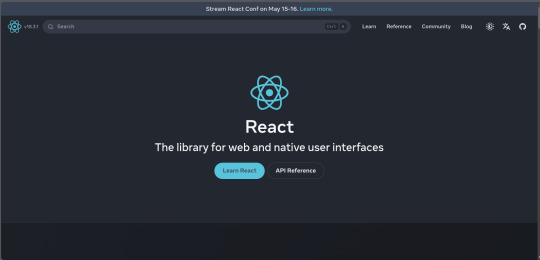
2. Angular
Angular, backed by Google, is a powerful framework for building dynamic single-page applications (SPAs).
Why Choose Angular?
Two-Way Data Binding: Synchronizes data between the model and the view.
Dependency Injection: Improves code maintainability and testability.
Comprehensive Documentation: Extensive resources for learning and troubleshooting.
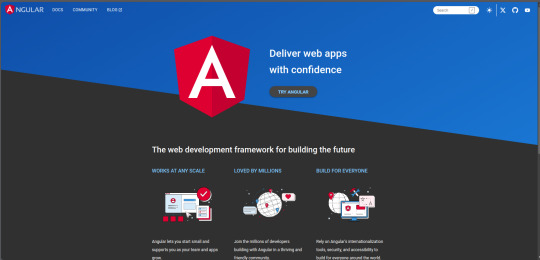
3. Vue.js
Vue.js has gained popularity due to its gentle learning curve and versatility.
Advantages of Vue.js
Reactive Data Binding: Simplifies state management.
Single-File Components: Encapsulate HTML, CSS, and JavaScript in one file.
Flexibility: Can be used for both large-scale and small-scale applications.
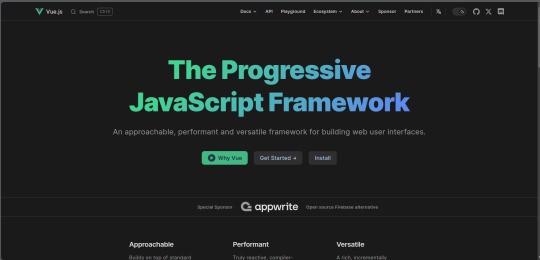
4. Svelte
Svelte is a relatively new player that compiles components into highly efficient vanilla JavaScript at build time.
Svelte’s Standout Features
No Virtual DOM: Directly manipulates the DOM for better performance.
Less Boilerplate: Cleaner code with minimal overhead.
Ease of Use: Intuitive and straightforward syntax.

5. Bootstrap
Bootstrap is a front-end framework that provides pre-designed components and a responsive grid system.
Benefits of Using Bootstrap
Responsive Design: Ensures your site looks great on all devices.
Pre-Styled Components: Saves time with ready-to-use UI elements.
Customizable: Easily customize with Sass variables and Bootstrap’s extensive options.
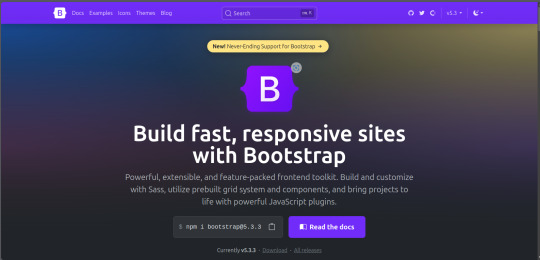
6. Tailwind CSS
Tailwind CSS is a utility-first CSS framework that allows for rapid UI development.
Tailwind CSS Features
Utility-First Approach: Use utility classes directly in your HTML.
Customizable: Extensive configuration options to suit your project’s needs.
Consistency: Enforces a consistent design language across your project.

7. Ember.js
Ember.js is a robust framework for building ambitious web applications.
Why Ember.js Stands Out
Convention over Configuration: Reduces the amount of decision-making and boilerplate code.
Strong Routing: Powerful routing capabilities for managing application state.
Productivity: Focuses on developer productivity with built-in best practices.
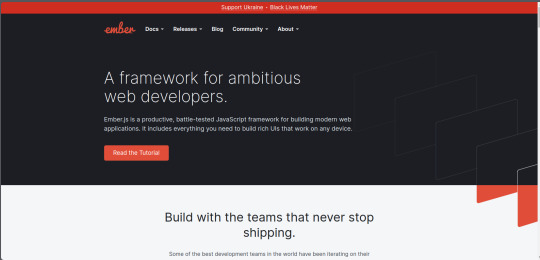
8. Alpine.js
Alpine.js offers a minimal and lightweight way to add interactivity to your websites.
Key Features of Alpine.js
Lightweight: Small footprint with only a few kilobytes.
Declarative Syntax: Similar to Vue.js, making it easy to understand and implement.
Ease of Integration: Can be easily integrated into existing projects.
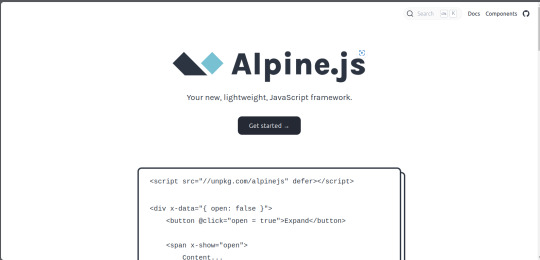
9. Next.js
Next.js is a popular React framework that enables server-side rendering and static site generation.
Benefits of Using Next.js
Server-Side Rendering (SSR): Improves performance and SEO by rendering pages on the server.
Static Site Generation (SSG): Pre-renders pages at build time for fast load times.
API Routes: Allows you to create API endpoints within your application.

10. Lit
Lit is a simple library for building fast, lightweight web components.
Advantages of Lit
Web Components: Embraces the web components standard for reusable, encapsulated HTML elements.
Performance: Lightweight and highly performant.
Simple API: Easy to learn and use with a minimal API surface.
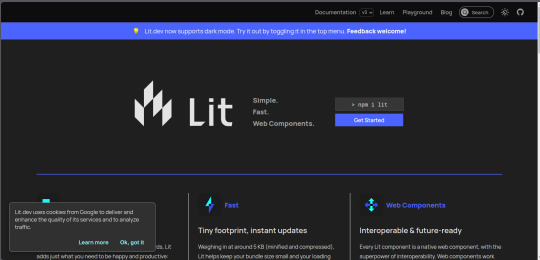
Conclusion
Choosing the right front-end framework or library can significantly impact your workflow and the quality of your projects. Whether you prefer the flexibility of React, the structure of Angular, or the simplicity of Svelte, there's a tool out there to suit your needs.
Final Tips for Selecting a Framework or Library
Project Requirements: Consider the specific needs of your project.
Community and Support: Look for frameworks with strong community support and documentation.
Learning Curve: Choose a tool that matches your current skill level and the time you have available to learn.
By staying informed about the latest tools and trends, you can ensure that your skills remain relevant and that you can deliver the best possible results in your projects. Happy coding!
Remember, the best tool is the one that helps you get the job done efficiently and effectively. So, dive into these frameworks and libraries, and take your front-end development skills to the next level!
Share Your Thoughts
I'm curious to know your thoughts on these front-end frameworks and libraries. Have you used any of them in your projects? Which one is your favorite, and why? Share your experiences and insights in the comments below.👇
2 notes
·
View notes
Text
Master the Recipe for Success: DevOps Training to Fuel Innovation and Growth
In today's technology-driven world, businesses across industries are constantly striving to enhance their operations and stay ahead of the competition. Successful companies understand that innovation and growth go hand in hand, and one key ingredient in this recipe for success is DevOps training. By investing in DevOps education and information technology (IT), organizations can equip their teams with the necessary skills and knowledge to streamline development processes, promote collaboration, and drive efficiency. This article explores the significance of DevOps training and how it can fuel innovation and growth within an organization.

The Advantages of DevOps Training
DevOps training offers numerous benefits to organizations seeking to optimize their development lifecycle and foster a culture of innovation. Here are some advantages associated with investing in DevOps education:
Enhanced Collaboration: DevOps training promotes a collaborative mindset by breaking down silos between development and operations teams. Through cross-functional training, individuals gain a deeper understanding of each other's roles, fostering communication and cooperation.
Streamlined Development Processes: With a strong DevOps foundation, businesses can streamline their development processes by implementing automation, continuous integration, and continuous delivery (CI/CD) practices. These streamlined processes reduce bottlenecks, minimize errors, and accelerate time-to-market.
Improved Efficiency and Productivity: By equipping employees with the necessary skills to effectively utilize DevOps tools and techniques, organizations can dramatically enhance efficiency and productivity. Training empowers team members to leverage automation tools, optimize workflows, and reduce manual effort.
Better Quality and Reliability: Through DevOps education, individuals gain expertise in implementing robust testing practices and quality assurance techniques. This results in improved software reliability, minimal downtime, and enhanced customer satisfaction.
Exploring DevOps Training Options
When considering DevOps training, organizations have a range of options to choose from. These options cater to diverse learning preferences and can be tailored to meet specific business needs. Here are some popular DevOps training choices:
1. Instructor-Led Training
Instructor-led training programs offer a structured approach to learning, combining theoretical concepts with hands-on exercises. Students benefit from real-time interaction with experienced instructors and fellow learners, fostering a deeper understanding of DevOps principles and best practices.
2. Online Courses
Online courses provide flexibility and convenience for individuals seeking to acquire DevOps skills at their own pace. These courses often consist of pre-recorded videos, interactive quizzes, and comprehensive learning materials. Students can access the content anytime, anywhere, making it ideal for busy professionals.
3. Certifications
Obtaining a recognized DevOps certification can be a valuable asset for career advancement and professional growth. Certifications validate an individual's expertise in DevOps methodologies and tools, instilling confidence in employers and clients alike. Several reputable organizations offer DevOps certifications, such as the DevOps Institute and Amazon Web Services.

The Role of IT in DevOps Training
Information technology plays a pivotal role in enabling successful DevOps training initiatives. IT teams act as facilitators, providing the necessary infrastructure, tools, and resources to support training efforts. Here are essential aspects of IT's involvement:
Provision of Training Environments: IT departments ensure the availability of training environments, such as virtual machines or cloud-based labs, where learners can practice deploying software, configuring systems, and working with various DevOps tools.
Management of Training Platforms: IT teams oversee and maintain the learning platforms used for delivering DevOps training. This involves ensuring proper access control, monitoring system performance, and troubleshooting any technical issues that may arise.
Support for Tool Adoption: IT professionals assist in the adoption and integration of DevOps tools into existing systems. This includes providing guidance on tool selection, configuration, and customization to align with an organization's unique requirements.
Security and Compliance Considerations: IT personnel play a crucial role in ensuring that all training activities align with security policies and compliance regulations. They implement measures to protect sensitive data, secure communication channels, and maintain the integrity of training environments.
DevOps training serves as a catalyst for innovation and growth within organizations by fostering collaboration, streamlining development processes, improving efficiency, and promoting quality. By investing in ACTE institute DevOps training options, businesses can equip their teams with the knowledge and skills needed to adapt and thrive in an ever-evolving digital landscape. With the crucial support of information technology, organizations can maximize the potential of DevOps training and embark on a path towards sustained success.
9 notes
·
View notes
Text
AWS Training: Your Ticket to Thrive in the Cloud Computing Revolution!
In’s rapidly evolving technological landscape, cloud computing has emerged as a game-changer, revolutionizing the way businesses operate and individuals engage with digital services. Among the numerous cloud service providers, Amazon Web Services (AWS) stands tall as a pioneer and leader in the field. Understanding the impact of AWS and gaining proficiency in its functionalities can be your passport to success in the world of cloud computing. This article aims to shed light on the significance of AWS training and how it can empower you to navigate the cloud computing revolution.

A Pattern Shift in Cloud Computing
Embracing AWS as a Leading Cloud Service Provider
As the demand for cloud-based solutions escalates, AWS has solidified its position as the go-to platform for individuals and organizations across the globe. With a versatile range of services encompassing computing power, storage, networking, databases, and more, AWS offers an unmatched infrastructure to support diverse business needs. By undertaking AWS training, you can unlock the full potential of these services, harnessing the capabilities of AWS to drive innovation, scalability, and cost optimization for your projects.
Mastering the Fundamentals: Essential Concepts and Services
Before delving into the vast AWS ecosystem, it is crucial to build a strong foundation by understanding the fundamental concepts and services. AWS training provides an organized curriculum that guides you, step by step, through the basics of cloud computing, AWS architecture, and key services like Amazon Elastic Compute Cloud (EC2), Simple Storage Service (S3), and Relational Database Service (RDS). By familiarizing yourself with these core components, you gain the necessary knowledge and skills to embark on your cloud computing journey confidently.
Navigating the AWS Training Journey
Comprehensive Learning Paths: From Newbie to Expert
AWS offers a diverse range of training options tailored to meet the needs of individuals at various skill levels. Whether you are a beginner looking to understand the basics or an experienced professional seeking to specialize in a particular domain, AWS training has got you covered. With structured learning paths designed for architects, developers, data engineers, and more, you can embark on a journey that aligns with your career aspirations. The systematic progression ensures that you acquire the right knowledge, hands-on experience, and certifications to excel in your chosen field.
Hands-On Labs and Real-World Scenarios: Learning by Doing
One of the most effective ways to master AWS is through hands-on experience, and AWS training excels in providing just that. By incorporating practical labs and real-world scenarios, training courses simulate the challenges you are likely to face in actual job roles. This experiential learning approach equips you with the ability to apply theoretical knowledge in practical scenarios, fostering a deeper understanding of AWS services and their practical implications. Furthermore, the training platform provides a safe environment for experimentation, enabling you to explore and experiment with different AWS configurations without the fear of disrupting production systems.
Expert Guidance and Community Support: Learning Together
AWS training goes beyond self-paced courses, offering opportunities for interaction and collaboration with experts and peers. Instructors with rich industry experience provide guidance and support throughout your learning journey, ensuring that you receive the necessary expertise to overcome hurdles and gain insights from their practical wisdom. Additionally, AWS training fosters a vibrant community where learners can actively engage, share experiences, and seek advice from fellow enthusiasts. This sense of camaraderie and shared learning creates a supportive ecosystem that enhances your growth and enriches your AWS training experience.

AWS Certifications: Showcasing Your Proficiency
Recognized Industry-Standard Certifications
To validate your AWS expertise and stand out in a competitive job market, AWS offers a comprehensive certification program. These industry-recognized certifications are a testament to your proficiency in various AWS services and demonstrate your commitment to continuous learning. By obtaining AWS certifications, you gain a competitive edge, making you an attractive candidate for job opportunities that require cloud computing skills. From foundational certifications like AWS Certified Cloud Practitioner to specialized roles like AWS Certified Solutions Architect or AWS Certified Machine Learning Specialist, AWS training equips you with the knowledge and credentials to showcase your capabilities effectively.
The cloud computing revolution is here to stay, and harnessing the power of AWS can unlock a world of opportunities. By investing in AWS training at ACTE institute, you equip yourself with the skills, knowledge, and certifications needed to thrive in this transformative landscape. From mastering the fundamental concepts to navigating the vast AWS ecosystem, the comprehensive learning paths, hands-on labs, expert guidance, and industry-recognized certifications pave the way for your success. Embrace the cloud computing revolution, embark on your AWS training journey, and witness firsthand how it propels you towards professional excellence in the ever-evolving world of cloud computing.
10 notes
·
View notes
Text
More Inform Basics (#2)
Last time, I talked about getting a project ready. We're still doing that, but I need to take a minute to talk about output. There aren't a lot of options for configuring the appearance of text output in default Inform.
If this seems surprising, remember that the original prototypes for parser games, Adventure and Zork, were written to be experienced via mainframe terminals. Later iterations upon this model used virtual machines that prioritized portability over system-specific features. There were tons of micros in the 80s, and each did things their own way. This method made it possible to port games to many different systems.
The bottom line is that most features related to appearance (font, colors, etc.) are not in the "story" at all*; they're handled by what is called the "interpreter." The story is the actual game file. An interpreter executes the game. The story is platform-agnostic; the interpreter is system-specific. In an interpreter application, a player can change some formatting settings themselves. In a browser-based interpreter, the author can mess with CSS if they are in a position to publish the game somewhere, since web browsers don't have settings specific to parser games.
[*Technically, there are ways to set colors in an Inform game, but the method doesn't work with all interpreters. Unless you publish a web-playable version, you can't control which interpreters players use.]
Whew, TL;DR: vanilla Inform's DNA is descended from a mainframe terminal model. Why is this important? Well, there are still some things under your control as an author, and it's best to do this in a simple, readable way.
Almost everything the player sees is coded with a "say" construction. If we want to print some text just as the game begins (before the player's first turn), we could just:
when play begins: say "Thank you for playing my game!".
[note: I couldn’t find a way to insert a tab, so I used five spaces instead. tabs are important in Inform 7!]
Let's say we wanted to say something after the player examines a lamp:
after examining the lamp: say "I think we did the right thing, choosing to examine that lamp."
Trying to tie everything together: we have a condition that gets set at compile time (test vs. production). We talked about this last time:
PROD is a truth state that varies.
Next time, we'll try using the PROD condition while tweaking output. It's pretty straightforward!
12 notes
·
View notes
Text
A friend of mine asked me recently to detail my Linux setup, and after thinking about it for a bit, I realized that this is essentially a personality quiz for the Linux users I thought I would detail it here as well.
I no longer have a desktop computer at all. I have two older generation "gaming" laptops and three Raspberry Pis. I'm going to go through in the order I got them:
Laptop #1:
[Purchased New in 2016] Acer ROG 7th Gen i7, 16GB Ram, nVidia 1050Ti Mobile, Internal 1TB HDD, external 2TB HDD
This was originally a windows laptop when I got it back in 2016, but in 2021 I was tired of the long windows boot times on the the HDD and was much more familiar with Linux due to several years experience doing webserver admin work.
I use Ubuntu LTS as my base. It's easy, it's well supported, it's well documented, and the official repos have just about everything I could need. The only thing I've really had to add myself is the repo for i3, but we'll get to that in a bit. I also chose Ubuntu because I already had my first two Raspberry pis, and both were running Raspbian, so using a debian based kernal meant that it wouldn't be much of a change when ssh'ing into them.
That said, I've never really liked the default Ubuntu desktop. Gnome3 is slow and full of too many effects that don't look especially nice but are still heavy to execute. Instead I loaded up KDE plasma. You can download Kubuntu and have them to the setup for you, but I did it the hard way because I found out about Plasma after installing Ubuntu and didn't want to start from scratch.
My plasma desktop looks like this:

Of my two laptops, this one is in the best shape. It's the one that I usually take with me on trips. With the dedicated GPU it can do some light gaming (it did heavier gaming on windows, but due to emulation layers the performance is just a little worse these days, Linux gaming isn't perfect), the screen hinge has never been an issue, and it's on the lighter side of gaming laptops (which is not to say that it's light). For that reason, I often find myself actually using it on my lap, in airports, at people's houses, on my own couch typing this up.
For this reason, I started looking into ways to better keep my hands on the keyboard, rather than having to drift down to the track pad, which is my least favorite part of this laptop. During that research I discovered i3. If you're not familiar i3 is a Linux Desktop Environment that is entirely keyboard driven. https://i3wm.org/
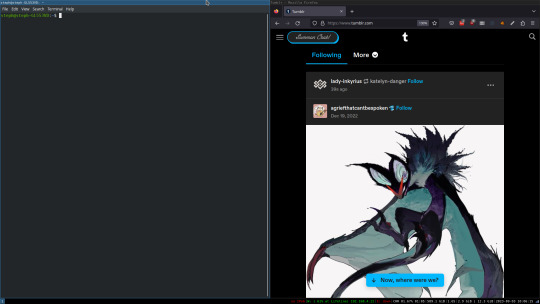
To be fair, it's less of a desktop environment and more of a keyboard driven window manager, as it doesn't have a "desktop" per se. Instead when you log into it, you simply get a black status bar at the bottom of the screen. It doesn't even black out the login screen, so if you don't know what to look for, you might think the whole thing has hung. But, the big benefit of this is that the whole thing is lighting fast for a DE. It doesn't waste any resources on effects or really anything that you don't need. But it's really nice for window tiling and task switching without having to get the mouse involved. This is great for productivity (if you're into that), but it's also just convenient for working on a gaming laptop, which might be balanced such that if you take your hands off of it, it might topple off your lap.
This laptop is my primary project computer. It has all my git repos and scripts for doing things like renewing my website's ssl certs. I also run game servers on it for Minecraft. I'm probably going to spin up a Valheim server on it in the near future too. Especially now that the process has improved somewhat.
Raspberry Pi #1:
[Gifted New in 2016] Raspberry Pi 3b, 4GB RAM, 32GB SD card
This one is my oldest RPi. It's had a lot of roles through the years, including an early version of the vogon media server during initial development in 2020. It's run headless Raspbian for a good three or four years now. Currently it's configured as a web server/php scripted web crawler and a pi-hole DNS server. My router currently refuses to use it as a DNS server without bringing the whole network down, but I will on occasion manually switch devices to it when I'm running especially ad-ridden applications.
There's not too much to say about this one. It's stable, I almost never have problems with it. I frequently use it for things that I want running in the background because they'll take too long and I don't want them blocking up one of my other computers.
Laptop #2
[Gifted Used in 2020] Asus Predator 7th Gen i7, 16GB Ram, nVidia 1080 Mobile, 2 internal 256GB SSDs, External 2TB HDD
This one runs windows 10 still. I use this primarily for gaming. The screen hinge is an absolute joke, and replacing it involves replacing the entire screen bezel assembly, which I can absolutely do, but is such a pain that I haven't gotten around to it in the 3 years I've owned this laptop.
There's nothing really special about this one, other than that when both laptops are at my desk, I use a KVM switch to swap my external monitor, keyboard, and trackball between the two computers.
Raspberry Pi #2:
[Gifted New in 2020/21] Raspberry Pi 4b, 4GB Ram, 16GB SD card, 2 120GB USB Sticks, External 2TB HDD
This is my media server. I got it for Christmas 2020 (or 2021, I don't actually remember which because 2020 was a hard hard year). It runs Rasbian, the full OS, with the desktop environment disabled from booting via the command line. It runs PHP 8.2, MariaDB, Apache2, and MiniDLNA to serve the content via my Vogon Media Server.
If you can't tell from the above storage, I'm running the USB ports well past the power delivery they are rated for. The webserver and OS are on the internal storage, so functionally this just means that sometimes the media disappears. I need to build a migration script to put the contents of the two USB sticks on the external storage, as there is more than enough room, and if I can put the HDD in an enclosure with dedicated power, that will solve the issue. But that's at least a hundred dollars of expense, and since the server only has 1, maybe two users at a time, we've been limping along like this for a few years now.
Raspberry Pi #3:
[Purchased New in 2023] Raspberry Pi 4b, 8GB Ram, 16GB SD card
This is the newest Pi. Work gave me a gift card as a bonus for a project recently, so after weighing the pros and cons of getting a VR headset, I settled on setting up a retro gaming tv box. Currently it's running Batocero Linux and loaded up with classic game roms up through the PSX. Though, I would really like to use it as a tv client for the media server. I've upgraded the devices in the living room recently, and there's no longer a dedicated web browser we can use without hooking up one of our laptops. I've got a spare 128GB SD card in the office, so I'm strongly considering getting a wireless mouse and keyboard and setting it up to dual boot between Batocero (which is convenient because it can be navigated with just a controller), and Raspbian. I think I'd set Batocero as the default in Grub, and then if I want to use Raspbian I'd need to have the keyboard handy anyway.
Maybe I'll get one of those half-sized keyboards with the trackpad built in.
Speaking of controllers. I use an 8BitDo Pro 2 controller, and I've been super happy with it since purchase: https://www.8bitdo.com/pro2/
So that's the setup. I have entirely too many computers for any one person, but I included the dates when I got them to show that a number of these have been around for a long time, and that part of the reason I have so many now is that I've put a lot of time into ongoing maintenance and repurposing.
If you've read this far, I'd love to hear about your setups. You don't have to reblog this, but please tag me if you detail yours.
5 notes
·
View notes
Text
Advanced Web Development Tools For Efficient PHP Developers

Web Development is working with frontend and backend both languages that are used by programmers and developers to build a well-functioning website or web application. Some of the most commonly used frontend languages are JavaScript, Angular, React, and Vue and backend languages are Python, Java, PHP, and C#.
PHP is the fastest and most widely used server-side scripting language that is ubiquitous in websites and web app development. It is known as a general-purpose scripting language that can be used to develop dynamic and interactive websites. It offers plenty of frameworks and supports several automation tools for application testing and deployment.
Nowadays the market is flooded with many PHP tools, and choosing the right one from among them is a challenging task. Here, we have made a list of leading tools that your development team can utilize to build feature-rich and innovative PHP webs and applications in 2023.
PHPStorm
PHPStorm is the most standard choice because of its nature of being lightweight, extremely fast, and smooth. It simplifies time-consuming tasks such as static code analysis, debugging, and generating functions. PHPStorm is compatible with many frameworks like Symphony, Drupal, Zend, WordPress, Magento, Laravel, etc.
Sublime Text
One of the most customizable, as well as malleable text editors out there for PHP developers, is Sublime Text. This cross-platform source code editor natively supports multiple coding and native mark-up languages.
AWS Cloud9
One of the main benefits of AWS Cloud9 is it is a cloud-based service, which means that it can be accessed from any computer with an internet connection. AWS Cloud9 comes with a code editor, terminal, debugger, and all necessary programming language tools, such as JavaScript, Python, and PHP, etc. It is an impressive feature-filled software that facilitates real-time code collaboration.
Netbeans
Netbeans supports building large-scale web apps and offers a range of languages like English, Simplified Chinese, Brazilian, Japanese, Portuguese, and Russian. It is considered one of the best software for PHP development and is most commonly used for developing PHP applications.
Aptana Studio
Aptana Studio is an open-source integrated development environment (IDE) for building dynamic web applications that use AJAX, PHP, JavaScript, and Ruby on Rails as well as HTML and CSS. It is enabling developers to develop web apps quickly and easily. Its core features include a code assist, built-in terminal, deployment wizard, and integrated debugger.
CodeLobster
CodeLobster IDE from Codelobster software company is the most popular well-liked PHP dev tool for the developer community. It endorses most PHP frameworks like Drupal, Joomla, Symfony, CodeIgniter, Magneto, CakePHP, etc. It supports numerous plugins and a PHP debugger to validate code. It can accelerate and simplify the development process.
Eclipse
It has a huge community of developers who work on all sorts of plug-ins and equip Eclipse with features. Eclipse features include the Eclipse ecosystem, code assist, syntax highlighting, code templates, syntax validation, code formatting, code navigation, and PHP debugging. These features make it easier for you to write better code.
Zend Studio
Zend Studio is a complete Integrated Development Environment (IDE) for professional PHP Web development, debugging, deploying, and managing PHP apps. It is a suitable option for anyone who wants to develop web applications with PHP version 5.5 and above. It offers fast coding along with an intelligent code editor and integrates with Zend Debugger, X-ray, and Xdebug.
These PHP web tools will set up configuration, complete your code intelligently, help to navigate, and check for errors. They are generally open-source and offer excellent features like syntax highlighting and debugging. They will help increase your productivity and efficiency. If you’re planning to get a web app with PHP, then you can contact Swayam Infotech and schedule a meeting for a detailed discussion. Our PHP experts will guide you with your requirements in a perfect way.
#PHP#php developer#php developers#php development#php development solutions#PHP Web Development#php website#php website development#phpdevelopment#Web Developers#Web Development#web development services#website Development#websites
5 notes
·
View notes
Text
Exploring the Powerhouse: 30 Must-Know JavaScript Libraries and Frameworks for Web Development
React.js: A declarative, efficient, and flexible JavaScript library for building user interfaces.
Angular.js (Angular): A web application framework maintained by Google, used for building dynamic, single-page web applications.
Vue.js: A progressive JavaScript framework for building user interfaces. It is incrementally adaptable and can be integrated into other projects.
Node.js: A JavaScript runtime built on Chrome's V8 JavaScript engine that enables server-side JavaScript development.
Express.js: A web application framework for Node.js that simplifies the process of building web applications.
jQuery: A fast, small, and feature-rich JavaScript library that simplifies HTML document traversal and manipulation, event handling, and animation.
D3.js: A powerful library for creating data visualizations using HTML, SVG, and CSS.
Three.js: A cross-browser JavaScript library and application programming interface (API) used to create and display animated 3D computer graphics in a web browser.
Redux: A predictable state container for JavaScript apps, often used with React for managing the state of the application.
Next.js: A React framework for building server-side rendered and statically generated web applications.
Svelte: A radical new approach to building user interfaces. It shifts the work from the browser to the build step, resulting in smaller, faster applications.
Electron: A framework for building cross-platform desktop applications using web technologies such as HTML, CSS, and JavaScript.
RxJS: A library for reactive programming using Observables, making it easier to compose asynchronous or callback-based code.
Webpack: A module bundler for JavaScript applications. It takes modules with dependencies and generates static assets representing those modules.
Babel: A JavaScript compiler that allows developers to use the latest ECMAScript features by transforming them into browser-compatible JavaScript.
Jest: A JavaScript testing framework designed to ensure the correctness of your code.
Mocha: A feature-rich JavaScript test framework running on Node.js and in the browser.
Chai: A BDD/TDD assertion library for Node.js and the browser that can be paired with any testing framework.
Lodash: A modern JavaScript utility library delivering modularity, performance, and extras.
Socket.io: A library that enables real-time, bidirectional, and event-based communication between web clients and servers.
GraphQL: A query language for APIs and a runtime for executing those queries with your existing data.
Axios: A promise-based HTTP client for the browser and Node.js, making it easy to send asynchronous HTTP requests.
Jasmine: A behavior-driven development framework for testing JavaScript code.
Meteor.js: A full-stack JavaScript platform for developing modern web and mobile applications.
Gatsby.js: A modern website framework that builds performance into every website by leveraging the latest web technologies.
Chart.js: A simple yet flexible JavaScript charting library for designers and developers.
Ember.js: A JavaScript framework for building web applications, with a focus on productivity and convention over configuration.
Nuxt.js: A framework for creating Vue.js applications with server-side rendering and routing.
Grunt: A JavaScript task runner that automates common tasks in the development process.
Sass (Syntactically Awesome Stylesheets): A CSS preprocessor that helps you write maintainable, scalable, and modular styles.
Remember to check each library or framework's documentation and community support for the latest information and updates.
4 notes
·
View notes
Text
Win Mobile and PC Monitoring Software: A Comprehensive Guide
In an era where digital devices are an integral part of our daily lives, monitoring and managing their usage have become essential. Whether you're a concerned parent, a business owner, or an individual looking to ensure the security of your devices and data, Win Mobile and PC monitoring software can be a valuable tool in your arsenal. In this article, we will explore the world of monitoring software for Windows-based computers and mobile devices, highlighting their features, benefits, and considerations.
Understanding Win Mobile and PC Monitoring Software
Win Mobile and PC monitoring software, often referred to as computer or mobile monitoring software, is a category of software designed to track and record activities on Windows-based computers and mobile devices. These tools serve various purposes, from parental control and employee monitoring to security and data protection. Let's delve into their key features and applications.
Key Features
Activity Logging: Monitoring software records a wide range of activities, including keystrokes, web browsing history, application usage, and file transfers. This comprehensive logging helps users gain insights into what happens on the monitored device.
Screen Recording: Some advanced monitoring tools can capture screenshots or record the screen in real-time, allowing you to see exactly what the user is doing on their device.
Remote Access: Many monitoring programs offer remote access capabilities, enabling users to view the monitored device's screen or perform certain actions from a remote location. This can be particularly useful for troubleshooting or parental guidance.
Alerts and Notifications: Monitoring software can be configured to send alerts and notifications when specific keywords are detected in messages or when certain actions are taken, helping users stay informed in real-time.
GPS Tracking: Mobile monitoring solutions often include GPS tracking features, allowing you to track the physical location of a mobile device in real-time.
Applications
Parental Control: Parents can use monitoring software to keep an eye on their children's online activities, ensuring they are safe and responsible online. It helps in preventing exposure to inappropriate content and managing screen time.
Employee Monitoring: Businesses can use monitoring software to increase employee productivity, monitor workstation usage, and protect sensitive company data from insider threats.
Security: Monitoring software can act as a security tool by identifying and preventing unauthorized access, potentially saving sensitive data from theft or loss.
Data Recovery: In case of device theft or data loss, monitoring software can help track the device's location or recover important files and data.
Considerations and Ethics
While Win Mobile and PC monitoring software offer significant advantages, there are ethical and legal considerations to keep in mind:
Legal Compliance: Ensure that your use of monitoring software complies with local and international laws. Unauthorized monitoring can result in legal consequences.
Privacy: Respect the privacy of individuals being monitored, especially in a personal or workplace context. Transparent communication is key.
Consent: In many cases, obtaining consent from the individuals being monitored is essential and legally required.
Conclusion
Win Mobile and PC monitoring software can be a powerful ally in ensuring the safety, productivity, and security of your digital devices and data. However, it's crucial to use such software responsibly, ethically, and in compliance with applicable laws and regulations. Whether you're a parent, an employer, or an individual concerned about your own digital security, choosing the right monitoring software and using it judiciously can make a significant difference in your digital world.
Ready to take control of your digital world and ensure the security and productivity of your devices? Don't wait any longer; it's time to explore the benefits of Win Mobile and PC monitoring software. Here's your call to action:
Choose the Right Software: Begin by researching and selecting the monitoring software that best suits your needs. Look for reputable options with the features you require.
Download and Install: Download the chosen software from a trusted source and follow the installation instructions carefully.
Configure and Customize: Take the time to configure the software to your preferences. Customize alert settings, access permissions, and monitoring parameters to align with your objectives.
Educate Yourself: Familiarize yourself with the software's features and capabilities. Understand how to use it effectively for your specific purposes.
Respect Privacy and Consent: If you're monitoring others, always ensure you have proper consent, and respect privacy laws and ethical guidelines.
Stay Informed: Keep yourself informed about updates and improvements to the software. Regularly check for updates to benefit from the latest security enhancements and features.
Seek Support: If you encounter any issues or have questions, don't hesitate to reach out to the software's support team or community for assistance.
Monitor Responsibly: Use the software responsibly and ethically, whether it's for parental control, employee monitoring, or security purposes. Balancing security with privacy is essential.
Now, take the first step towards a safer and more controlled digital environment. Download your chosen Win Mobile and PC monitoring software today and experience the peace of mind and productivity benefits it can offer. Your digital world is in your hands—make the most of it with monitoring software.
2 notes
·
View notes
Text
Demystifying Microsoft Azure Cloud Hosting and PaaS Services: A Comprehensive Guide
In the rapidly evolving landscape of cloud computing, Microsoft Azure has emerged as a powerful player, offering a wide range of services to help businesses build, deploy, and manage applications and infrastructure. One of the standout features of Azure is its Cloud Hosting and Platform-as-a-Service (PaaS) offerings, which enable organizations to harness the benefits of the cloud while minimizing the complexities of infrastructure management. In this comprehensive guide, we'll dive deep into Microsoft Azure Cloud Hosting and PaaS Services, demystifying their features, benefits, and use cases.
Understanding Microsoft Azure Cloud Hosting
Cloud hosting, as the name suggests, involves hosting applications and services on virtual servers that are accessed over the internet. Microsoft Azure provides a robust cloud hosting environment, allowing businesses to scale up or down as needed, pay for only the resources they consume, and reduce the burden of maintaining physical hardware. Here are some key components of Azure Cloud Hosting:
Virtual Machines (VMs): Azure offers a variety of pre-configured virtual machine sizes that cater to different workloads. These VMs can run Windows or Linux operating systems and can be easily scaled to meet changing demands.
Azure App Service: This PaaS offering allows developers to build, deploy, and manage web applications without dealing with the underlying infrastructure. It supports various programming languages and frameworks, making it suitable for a wide range of applications.
Azure Kubernetes Service (AKS): For containerized applications, AKS provides a managed Kubernetes service. Kubernetes simplifies the deployment and management of containerized applications, and AKS further streamlines this process.

Exploring Azure Platform-as-a-Service (PaaS) Services
Platform-as-a-Service (PaaS) takes cloud hosting a step further by abstracting away even more of the infrastructure management, allowing developers to focus primarily on building and deploying applications. Azure offers an array of PaaS services that cater to different needs:
Azure SQL Database: This fully managed relational database service eliminates the need for database administration tasks such as patching and backups. It offers high availability, security, and scalability for your data.
Azure Cosmos DB: For globally distributed, highly responsive applications, Azure Cosmos DB is a NoSQL database service that guarantees low-latency access and automatic scaling.
Azure Functions: A serverless compute service, Azure Functions allows you to run code in response to events without provisioning or managing servers. It's ideal for event-driven architectures.
Azure Logic Apps: This service enables you to automate workflows and integrate various applications and services without writing extensive code. It's great for orchestrating complex business processes.
Benefits of Azure Cloud Hosting and PaaS Services
Scalability: Azure's elasticity allows you to scale resources up or down based on demand. This ensures optimal performance and cost efficiency.
Cost Management: With pay-as-you-go pricing, you only pay for the resources you use. Azure also provides cost management tools to monitor and optimize spending.
High Availability: Azure's data centers are distributed globally, providing redundancy and ensuring high availability for your applications.
Security and Compliance: Azure offers robust security features and compliance certifications, helping you meet industry standards and regulations.
Developer Productivity: PaaS services like Azure App Service and Azure Functions streamline development by handling infrastructure tasks, allowing developers to focus on writing code.
Use Cases for Azure Cloud Hosting and PaaS
Web Applications: Azure App Service is ideal for hosting web applications, enabling easy deployment and scaling without managing the underlying servers.
Microservices: Azure Kubernetes Service supports the deployment and orchestration of microservices, making it suitable for complex applications with multiple components.
Data-Driven Applications: Azure's PaaS offerings like Azure SQL Database and Azure Cosmos DB are well-suited for applications that rely heavily on data storage and processing.
Serverless Architecture: Azure Functions and Logic Apps are perfect for building serverless applications that respond to events in real-time.
In conclusion, Microsoft Azure's Cloud Hosting and PaaS Services provide businesses with the tools they need to harness the power of the cloud while minimizing the complexities of infrastructure management. With scalability, cost-efficiency, and a wide array of services, Azure empowers developers and organizations to innovate and deliver impactful applications. Whether you're hosting a web application, managing data, or adopting a serverless approach, Azure has the tools to support your journey into the cloud.
#Microsoft Azure#Internet of Things#Azure AI#Azure Analytics#Azure IoT Services#Azure Applications#Microsoft Azure PaaS
2 notes
·
View notes
Text
Why should small businesses use digital marketing?
A business is a business, and I believe that regardless of size, all businesses should prioritize marketing their products in order to increase income and promote their brand.
Digital marketing is important in today's digital world, when social media has taken over most genuine human contacts and online marketplaces are prospering. Making an online presence for your company and building talk about it will undoubtedly be beneficial in the long term. Depending on the technique and overall brand tonality of your organization, digital marketing might be subtle or loud.

Small businesses can benefit from Digital Marketing by implementing the following strategies:
Creating a local Google presence (Google Business Profile)
Regular social media posting (Facebook, Instagram, etc.)
Making a website for products and services
Blogging about their niche/domain
Utilizing Google/Meta Ads

These strategies will undoubtedly aid in the establishment of authority for your company in the web industry. Furthermore, Digital Marketing provides numerous configurable choices that we may use based on the needs of our business, for example, you can run your ad on Facebook for as little as $1!
As a result, I am confident that adding digital marketing into your organization can help you reach new heights. I hope this was helpful!
#digital marketing#social media marketing#growth tips#seo#seo tips#marketing strategy#business growth#small business#marketing
3 notes
·
View notes